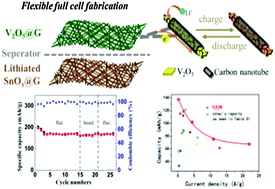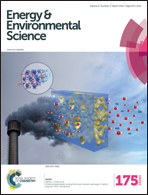Encapsulating V2O5 into carbon nanotubes enables the synthesis of flexible high-performance lithium ion batteries†
Abstract
Here, we have designed and successfully fabricated an interwoven nanocable architecture constructed by V2O5 nanosheets encapsulated within multi-graphitic nanotubes as a novel high performance flexible cathode for Li ion batteries. Such an integrated electrode designed via the multiscale system exhibits ultrafast and stable Li ion storage performance, with a capacity higher than 90 mA h g−1 even at 100 C and only 0.04% capacity decay per cycle over 200 cycles. To the best of our knowledge, this is the first example of the facile synthesis of flexible V2O5 encapsulated into carbon nanotube positive electrodes and the successful demonstration of a flexible full cell showing surprisingly consistent cycling stability and excellent mechanical properties with V2O5@G as cathodes and their allotrope as anodes. Remarkably, an energy density of ca. 360 W h kg−1 at a power rate of 15.2 kW kg−1 is achieved, which belongs to one of the best results reported so far on V2O5-based electrode materials. Coupled with a simple and scalable production protocol, the strategies are highly promising for both novel cathode exploration and for the practical fabrication and application of flexible energy storage devices.


 Please wait while we load your content...
Please wait while we load your content...